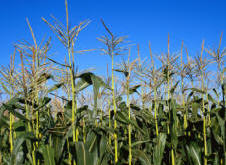

To send a message to an author, click on the author's name at the end of the article.
This Month in Ag Connection | Ag Connection - Other Issues Online

(Author: Don Day, Natural Resource Engineer)
This Month in Ag Connection | Ag Connection - Other Issues Online
Have you received a 2007 Agriculture Census form?
If not, please contact the National Agricultural Statistics Service Missouri Field Office at 800-551-1014 or visit www.agcensus.usda.gov online.
Completed forms are due by February 4, 2008.
Producers can return their forms by mail or, for the first time, they have the convenient option of completing the Census online via a secure web site.
This Month in Ag Connection | Ag Connection - Other Issues Online
From an agronomic perspective, corn following corn typically can have more problems and a lower yield than corn in a crop rotation, typically following soybeans. There are strategies that can be used to minimize the potential for problems. Bob Neilsen and several associates at Purdue have identified a plethora of issues with corn following corn.

Nitrogen issues
Optimum fertility rates for corn following corn are
higher than for corn following soybeans. Estimates range from 30 to 50
additional pounds of nitrogen per acre required, but yields may be 7 to 10%
lower. Higher nitrogen prices must be figured into budgets when comparing
cropping alternatives.
P and K fertility issues
Corn removes more phosphorous and less potassium per acre than soybeans. Second year corn will have little effect
on P & K levels but over a number of years levels should be monitored and
adjusted accordingly.
Stand establishment
Higher levels of residue can lead to slower warming and drying of the soil. Delayed stand establishment resulting from
delayed or uneven germination and emergence can increase the exposure of
seedlings to insects and diseases. Select hybrids with superior seedling
vigor. Avoid suboptimal soil temperatures by not planting too early. Manage
the residue by burying it or using row-cleaners.
Disease management
Corn residue can harbor inoculums for diseases
such as gray leaf spot and northern corn leaf blight. Select hybrids with
emphasis on resistance to specific diseases as well as on overall good plant
health. Consider burying the residue where possible. Consider using a foliar
fungicide. Experimental data from replicated trials suggest that economic
benefits of fungicide applications occur 60% of the time when significant
levels of disease are present.
Insect management
Corn rootworm is spreading throughout the cornbelt
and should be addressed where it has a history. Delayed emergence and growth
results in lengthier exposure of corn seedlings to secondary soil pests such
as wireworms, seedcorn maggots, white grubs and slugs. Crop residues and
live winter annual weeds can be attractive to cutworm and armyworm moths for
egg laying. Greater populations of corn borer moths may not be expected
because of the transgenic corn grown in the area. The judicious uses of
soil-applied insecticides, insecticide seed treatments or transgenic
resistance for rootworm are options.
Hybrid selection
Good hybrids for rotation corn tend to be good
hybrids for continuous corn. Chose hybrids that demonstrate consistent high
yield performance across multiple environments. After you identify good
yielding hybrids, select for disease resistance, stalk strength, stalk and
root health, seedling vigor and overall stress tolerance.
Weed management
Continuous corn limits weed control options compared
to a rotation. Soil applied herbicides should be used at full rates and post
emergent herbicides should be applied before weeds are more than 6 inches
tall. A combination of preemergence and post emergence weed control
strategies will usually result in the most effective weed program.
Glyphosate resistant weeds
With the increasing number of weeds
showing resistance to glyphosate, alternating weed control programs and
herbicide modes of action should be considered in continuous corn. Tillage
can also be an alternative.
Harvest season issues
More corn acres will effectively lengthen the
harvest season. Losses can increase and disease becomes a problem as the
crop remains in the field. Select hybrids with superior plant health and
stalk strength. Prioritize harvest to fields that show signs of
deterioration.
Bottom line
The decision whether to plant soybeans or plant
continuous corn should be made cautiously with careful attention to both the
economics and agronomics.
(Author: Wayne Crook, Agronomy Specialist)
This Month in Ag Connection | Ag Connection - Other Issues Online
University of Missouri has released the new herbicide updates for 2008. This year it will be available online at: http://ipm.missouri.edu/ipcm/ or by request from your local county office. The integrated crop management newsletter includes this listing and is available free electronically or in hardcopy form for $30 / year.
This Month in Ag Connection | Ag Connection - Other Issues Online
Homeowners should wait to cut down or prune trees damaged by winter ice storms. Unless they are an obvious hazard, it is wise to wait. It is difficult to predict how storm-damaged trees will respond. Ice storms can cause several types of tree injury due to the increased weight load. High winds aggravate the situation. Damage can be categorized as broken branches, bent branches or limbs, and main trunk or massive branch damage.

The most common damage is broken branches. Because of their year-round foliage, evergreen trees are particularly susceptible to this type of damage. When small- or medium-sized branches break off the main trunk, the tree forms a protective barrier of wound tissue. Lateral branches may grow from the remaining portion of the original branch and produce new foliage.
Do not be in a hurry to start pruning a branch that is bent out of shape. Do not try to remove ice from a tree's limbs, since additional damage due to breakage may occur. If you must remove damaged limbs, cut the damaged branch just above the limb's branch collar. The branch collar is the "donut-shaped" ring of growth around the limb as it attaches to a larger limb or the tree's trunk. If you remove this collar, then the tree cannot naturally close the wound, and you have an entry point for disease organisms and insects. If the damage is high up in the tree, you should call a certified arborist who has the experience and proper equipment to safely remove the affected limb(s).
The most serious damage, breaks or splits on the main trunk and on massive branches, usually occurs on large mature trees, such as silver maples and other trees where the branches grow at a narrow angle from the trunk. While not causing rapid tree death, such damage exposes large areas of wood to decay, which can progress rapidly and make the tree susceptible to further storm damage. As a rule of thumb, a tree that has lost less than 50 percent of its branches stands a reasonably good chance of recovering.
Trees bent over by a storm can sometimes be straightened by staking them upright. However, the tree may develop longitudinal cracks and splits that may not be obvious but serve as entry points for insects and diseases. Even trees that appear to straighten up within a few months are susceptible to this sort of damage.
More detail can be found in at MU Extension publications: http://extension.missouri.edu/main/DisplayCategory.aspx?C=1#publications
(Source: Chris Starbuck, 573-882-9630; H.E. 'Hank' Stelzer 573-882-4444)
This Month in Ag Connection | Ag Connection - Other Issues Online
If you have not met them previously this is an introduction to CRAT and CRUT. CRAT is the acronym for charitable remainder annuity trust and CRUT is the acronym for charitable remainder uni-trust. While there are a number of ways for making charitable transfers, from the financial security and income tax saving perspectives, CRAT and CRUT have a lot to offer.
CRATs and CRUTs are tax planning tools that almost allow you to have your cake and eat it too. As an example, let's say you would like to leave your favorite charity $50,000. Instead of making this provision in your will, you could set up a $50,000 charitable remainder annuity trust (CRAT) during your life. This trust could be set up to provide you with a yearly income as a percentage of the value of the trust assets. For our example, if six percent interest was paid on the principle - then you would receive $3,000 per year for the rest of your life.
Upon your death, whatever property remains in the trust would go to your designated charity. Even though the charity won't get the trust assets until your death, you are entitled to a current income tax deduction for the present value of the calculated remainder interest of the property placed in the trust for the charity. The value of the remainder interest is based upon published actuarial tables and interest rates. The older you are at the time of transfer of assets to the trust, the greater the remainder interest value. These tables do provide for joint lives, so the trust could be established to pay the fixed percentage income to you for life, then for your spouse's life, with the remainder interest going to the charity upon the last to die.
The charitable remainder uni-trust (CRUT), for the most part, only varies from the CRAT in that the periodic percentage payout is based on the periodic value of the trust, rather than the value of the trust property at the time it was established. This feature offers some income protection from inflation.
These types of transactions are gaining popularity with people who desire to recognize charities in their estate plan. While CRATs and CRUTs have many advantages, they should be utilized only after due consideration to insure they accomplish your estate planning goals and objectives.
(Author: Parman R. Green, Ag Business Management Specialist)
This Month in Ag Connection | Ag Connection - Other Issues Online
2008 Livestock, Crop and Forage Budgets can be found at: http://agebb.missouri.edu/mgt/budget/index.htm
In addition, the Food and Agriculture Policy Institute (FAPRI) generate budgets to represent medium sized farms. Their budgets can be accessed at: http://www.fapri.missouri.edu/farmers_corner/budgets/index.asp?current_page=farmers_corner
FAPRI also has a Budget Generator you can download. It can be found at: http://www.fapri.missouri.edu/farmers_corner/tools/index.asp?current_page=farmers_corner
(Author: Mary Sobba, Agriculture Business Specialist)
This Month in Ag Connection | Ag Connection - Other Issues Online
Publishing Information
Ag Connection is published monthly for Northeast and Central areas of Missouri producers and is supported by the University of Missouri Extension, the Missouri Agricultural Experiment Station, and the MU College of Agriculture, Food and Natural Resources. Managing Editor: Mary Sobba.